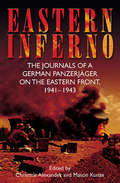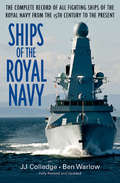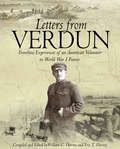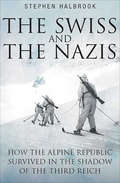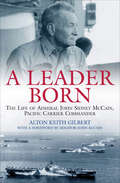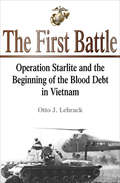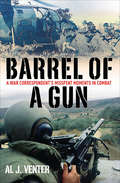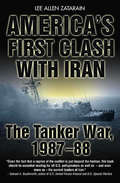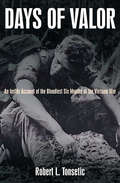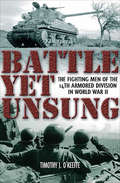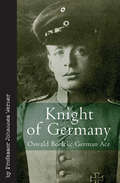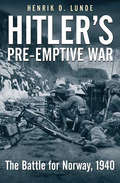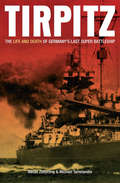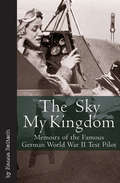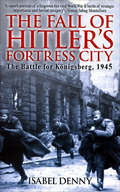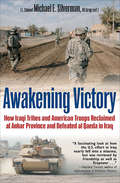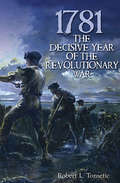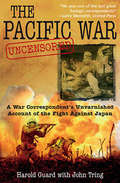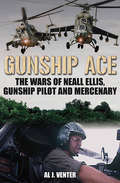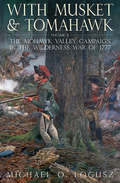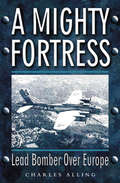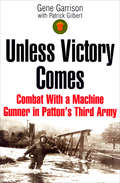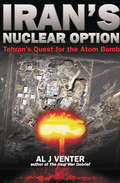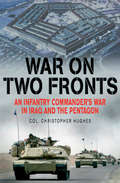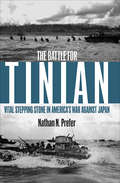- Table View
- List View
Eastern Inferno: The Journals of a German Panzerjäger on the Eastern Front, 1941–43
by Hans Roth&“Remarkable personal journals . . revealing the combat experience of the German-Russian War as seldom seen before . . . a harrowing yet poignant story&” (Military Times). Hans Roth was a member of the anti-tank panzerjager battalion, 299th Infantry Division, attached to the Sixth Army, as the invasion of Russia began. As events transpired, he recorded the tension as the Germans deployed on the Soviet frontier in June 1941. Then, a firestorm broke loose as the Wehrmacht tore across the front, forging into the primitive vastness of the East. During the Kiev encirclement, Roth&’s unit was under constant attack as the Soviets desperately tried to break through the German ring. At one point, after the enemy had finally been beaten, a friend serving with the SS led him to a site—possibly Babi Yar—where he witnessed civilians being massacred. After suffering through a brutal winter against apparently endless Russian reserves, his division went on the offensive again when the Germans drove toward Stalingrad. In these journals, attacks and counterattacks are described in you-are-there detail. Roth wrote privately, as if to keep himself sane, knowing his honest accounts of the horrors in the East could never pass Wehrmacht censors. When the Soviet counteroffensive of winter 1942 begins, his unit is stationed alongside the Italian 8th Army, and his observations of its collapse, as opposed to the reaction of the German troops sent to stiffen its front, are of special fascination. Roth&’s three journals were discovered many years after his disappearance, tucked away in the home of his brother. After his brother&’s death, his family discovered them and sent them to Rosel, Roth&’s wife. In time, Rosel handed down the journals to Erika, Roth&’s only daughter, who had emigrated to America. Roth was likely working on a fourth journal before he was reported missing in action in July 1944. Although his ultimate fate remains unknown, what he did leave behind, now finally revealed, is an incredible firsthand account of the horrific war the Germans waged in Russia.
Ships of the Royal Navy: The Complete Record of all Fighting Ships of the Royal Navy from the 15th Century to the Present
by J.J. Colledge Ben WarlowThe essential historical reference on British warships—fully revised. “Right at the top of the ‘must have’ list . . . A book which will get much use ” (Royal Navy and Maritime Book Reviews).This is the fourth fully revised edition of a book first published in 1970. This longevity is testimony to its enduring value as a reference work—indeed, “Colledge,” as the book is universally known, is still the first stop for anyone wanting more information on any British warship from the fifteenth century to the present day when only the name is known. Each entry gives concise details of dimensions, armament, and service dates, and its alphabetical and chronological arrangement makes it easy to track down the right ship—otherwise the Royal Navy’s tradition of reusing the same names can be misleading.When originally published, the second of the two volumes was devoted to minor fighting ships and hired and requisitioned vessels. For the third edition, published in one volume, this material was omitted, but for this edition, all the genuine fighting ships—like the numbered Coastal Forces craft—have been restored, resulting in a convenient but comprehensive single-volume listing of all significant vessels.Since the death of Jim Colledge, who was widely respected for his pioneering research on the technical details of warships, his magnum opus has been updated, corrected, and expanded with similar enthusiasm and attention to detail by Ben Warlow, a retired naval officer and author of a number of books in the field.“An amazing and immensely valuable work of dedicated and persistent research.” —Baird Maritime
Letters from Verdun: Frontline Experiences of an American Volunteer in World War I France
by Avery Royce WolfeThe dramatic experiences of an ambulance driver in the Great War, told through personal correspondence and photographs. Though the United States was late to enter the Great War, a number of idealistic young Americans wished to take part from the beginning. One of these was Avery Royce Wolf, a highly educated scion of a family in America&’s burgeoning industrial heartland. Volunteering as an ambulance driver with the French Army in the Verdun sector, Royce sent back a constant stream of highly detailed letters describing the experience of frontline combat, as well as comments on strategy, the country he encountered, and the Allies&’ prospects for success. This treasure trove of brilliant letters, only recently discovered, is accompanied by several albums worth of rare, high-quality photos depicting aspects of the Great War in France never previously published. Full of action, including the suspense and terror of the Ludendorff Offensive, and interesting firsthand analyses, such as comparing French and German trench works, Letters from Verdun brings the reader amazingly close to the frontlines of the Great War.
The Swiss and the Nazis: How the Alpine Republic Survived in the Shadow of the Third Reich
by Stephen HalbrookThe award-winning author of Target Switzerland uses “a wide breadth of research to attempt to answer why Switzerland escaped the Nazi onslaught” (Daly History Blog).While surrounded by the Axis powers in World War II, Switzerland remained democratic and, unlike most of Europe, never succumbed to the siren songs and threats of the Nazi goliath.This book tells the story with emphasis on two voices rarely heard. One voice is that of scores of Swiss who lived in those dark years, told through oral history. They mobilized to defend the country, labored on the farms, and helped refugees. The other voice is that of Nazi Intelligence, those who spied on the Swiss and planned subversion and invasion. Exhaustive documents from the German military archives reveals a chilling rendition of attack plans which would be dissuaded in part by Switzerland’s armed populace and Alpine defenses.Laced with unique maps and photos, the book reveals how the Swiss mobilized an active “spiritual defense” of their country—including the use of the press and cabaret as weapons against totalitarianism—and explores the role of women in the military and economy, the role of Jewish officers in the highest levels of the Swiss army, and the role of Switzerland itself as America’s window on the Reich. “Halbrook succeeds not only in achieving a thorough analysis of Switzerland’s armed neutrality, but also in revealing through their own voices the willingness of ordinary citizens to accept total war in order to preserve their freedom.”—Swiss American Historical Society Review
A Leader Born: The Life of Admiral John Sidney McCain, Pacific Carrier Commander
by Alton Keith GilbertThis biography of one of World War II’s great military leaders is a “rich tribute to a staunch American naval hero” (WWII Quarterly).John S. “Slew” McCain was an old-school sailor. Wiry, profane, a cusser, and a gambler, he reminded more than one observer of Popeye. He was also a pioneer in the hard-hitting naval tactics that brought Imperial Japan to its knees.McCain graduated from Annapolis in 1906 and served aboard an armored cruiser in World War I. Perceiving the future of naval warfare, he earned his aviation wings in 1936, and by 1939, McCain was commander of the aircraft carrier USS Ranger. He was thus well-placed to play a leading role in America’s cut-and-thrust war with the Japanese across the broad expanses of the Pacific. In 1942, he was made commander of all land-based aircraft during the campaign for Guadalcanal. Though he took his share of blame for the disaster at Savo Island, he counterattacked with every means at his disposal, to the point of commandeering the planes of the crippled carriers Enterprise and Saratoga to reinforce US strength on Henderson Field.By the time the US returned to the Philippines, McCain was leading a fast carrier task force under William “Bull” Halsey. When asked what he thought about his carrier commander, Halsey replied, “Not much more than my right arm.” McCain’s carrier group would destroy thousands of enemy planes and hundreds of ships with aggressive swarming tactics. Four days after Japan officially surrendered, McCain died in his bed. His name has lived on, however, through his son, who became commander of US naval forces in the Pacific, and his grandson, John S. McCain III, carrier pilot, Vietnam POW, and United States Senator.Drawing upon a wealth of primary sources, including information provided by the McCain family, as well as an expert grasp of the titanic battles waged by the US armed forces in the Pacific, Alton Keith Gilbert has provided the fullest account of the Admiral John McCain’s life yet written.
The First Battle: Operation Starlite and the Beginning of the Blood Debt in Vietnam
by Otto J. Lehrack&“[A] brief but well-told and well-researched account . . . a good description of early U.S. Marine deployments to Vietnam&” (HistoryNet). The First Battle is a graphic account of the Vietnam War&’s first major clash. On August 18, 1965, regiment fought regiment on the Van Tuong Peninsula near the new Marine base at Chu Lai. On the American side were three battalions of Marines under the command of Col. Oscar Peatross, a hero of two previous wars. His opponent was the 1st Viet Cong Regiment commanded by Nguyen Dinh Trong, a veteran of many fights against the French and the South Vietnamese. Codenamed Operation Starlite, this action was a resounding success for the Marines, and its result was cause for great optimism about America&’s future in Vietnam. Blood debt, han tu in Vietnamese, can mean revenge, debt of honor, or blood owed for blood spilled. The blood debt came into Vietnamese usage early in the war with the United States. With this battle, the Johnson Administration began compiling its own blood debt, this one to the American people. The book also looks at the ongoing conflict between the US Army and the US Marines about the methodology of the Vietnam War. With decades of experience with insurrection and rebellion, the Marines were institutionally oriented to base the struggle on pacification of the population. The Army, on the other hand, having largely trained to meet the Soviet Army on the plains of Germany, opted for search-and-destroy missions against Communist main force units. The history of the Vietnam War is littered with many &“what ifs.&” This may be the biggest of them.
Barrel of a Gun: A War Correspondent's Misspent Moments in Combat
by Al J. VenterA colorful, wide-ranging memoir of danger and adventure in wars around the world.Anybody who says that the pen is mightier than the sword hasn’t spent time in Somalia . . .So begins this memoir of a career spent examining warfare—on the ground and as the bullets are flying. While many are intrigued by these violent conflicts, Al Venter feels compelled to see them in person, preferably at the center of the action.Born in South Africa, Venter has found no shortage of horrific battles on his own continent, from Rhodesia to Biafra and Angola to Somalia. He has ridden with the legendary mercenary group Executive Outcomes; jumped into combat with South Africa’s crack Parachute Regiment, the Parabats; and traipsed through jungles with both guerrillas and national troops. During Sierra Leone’s civil war, he flew in the government’s lone Mi-24 helicopter gunship as it blasted apart rebel villages and convoys, complaining that the Soviet-made craft leaked when it rained.In the Mideast, he went into Lebanon with the Israeli army as it encountered resistance from multiple militant groups, including the newly formed Hezbollah. Curious about the other side of the hill, he joined up with General Aoun’s Christian militias while that conflict was at its height. Touching down in Croatia during the Balkan wars, and in Congo during their perpetual one, as well as the Uganda of Idi Amin, Venter never lost his lust for action, even as he sometimes had to put down his camera or notebook to pick up an AK-47.In his journeys, Venter associated with an array of similarly daring soldiers and journalists, from “Mad Mike” Hoare to Danny Pearl, as well as elite soldiers from around the world, many of whom, he sadly relates, never emerged from the war zones they entered. A renowned journalist and documentarian who has worked with the BBC, PBS, Jane’s, and other outlets, Al Venter here offers the reader his own personal experiences with combat.
America's First Clash with Iran: The Tanker War, 1987–88
by Lee Allen ZatarainA revealing account of the US conflict with Iran over the Persian Gulf during the Reagan era—and the groundwork it set for today&’s tensions. In May 1987, the US frigate Stark was blown apart by an Iraqi jet fighter in the Persian Gulf, jumpstarting a major conflict with Iran that came to be known as the Tanker War. In America&’s First Clash with Iran, author Lee Allen Zatarain employs Pentagon documents and firsthand interviews to reveal the full story of a conflict that may have presaged further battles to come. At the climax of the Iran-Iraq War, Iran was losing on the battlefield. Ayatollah Khomeini decided to close the Persian Gulf against shipping from Iraq&’s oil-rich backer, the emirate of Kuwait. When the United States sent a fleet to the Gulf, raising the Stars and Stripes over Kuwait&’s commercial tankers, a tinderbox was set off. The Iranians laid mines throughout the narrow passage and launched attack boats against both tankers and US warships. The US Navy fought its largest surface battle since World War II against the Ayatollah&’s assault boats. As Saddam Hussein looked on, Iranian gunners fired missiles against US forces—actions which, if made known at the time, would have required the US Congress to declare war against Iran.
Days of Valor: An Inside Account of the Bloodiest Six Months of the Vietnam War
by Robert L. TonseticA Vietnam War battalion commander with the 199th LIB recounts the intense combat he saw during the Tet Offensive and NVA attacks in this candid memoir. This visceral combat memoir chronicles the height of the Vietnam War from the nervous period just before the Tet Offensive through the defeat of that campaign and into the lesser-known yet equally bloody NVA offensive of May 1968. On January 30, 1968, Saigon and nearly every provincial capital in South Vietnam came under assault by the Viet Cong. Author Robert L. Tonsetic writes not only from his personal experience as a company commander, but also from extensive research, including countless interviews with other soldiers of the 199th Light Infantry Brigade. The book ends with a brief note about the 199th LIB being deactivated in Spring 1970, furling its colors after suffering 753 dead and some 5,000 wounded. This fascinating book will help to remind us of the sacrifices made by all Vietnam veterans.
Battle Yet Unsung: The Fighting Men of the 14th Armored Division in World War II
by Timothy J. O'Keeffe&“An incredible job in shedding light about an often neglected but important role this unit played in the defeat of Nazi Germany&” (WWII History). While headline writers in the European Theater of Operations were naturally focused on events in Normandy and the Bulge in the north, equally ferocious combats were taking place in southern France and Germany during 1944–45, which are now finally getting their due. The US 14th Armored Division—a late arrival to the theater—was thrust into intense combat almost the minute it arrived in Europe, as the Germans remained determined to defend their southern flank. This book explores in detail what happened in the month of January 1945 in the snow-covered Vosges Mountains, when the Wehrmacht&’s attempt to destroy the Sixth Army Group failed. A strategic withdrawal after ten hellish days of fiery combat allowed the Allies to hold the line until a spring offensive. In March, the division literally exploded its way through the Siegfried Line at Steinfeld and began to propel the Wehrmacht into a retreat from which it could never recover. Armored columns kept punching their way through roadblock after roadblock in town after town with powerful artillery and air concentrations that never gave the German soldiers a chance to respond. As a result of the rapid advance of Seventh Army and the 14th, German POW camps like the ones at Hammelburg and Moosburg were liberated of over 100,000 prisoners, an achievement which gave the division the nom de guerre &“The Liberators.&” &“A frontline soldier&’s view of how green troops became battle-wise and battle-weary veterans.&” —The Journal of America&’s Military Past
Knight of Germany: Oswald Boelcke German Ace (Vintage Aviation Library #Vol. 3)
by Johannes WernerThe story of the World War I fighter pilot the Red Baron himself sought to emulate . . .German air ace Oswald Boelcke was a national hero during World War I. He was the youngest captain in the German air force, decorated with the Pour le Mérite while still only a lieutenant, and credited with forty aerial victories at the time of his death.Becoming a pilot shortly before the outbreak of the war, Boelcke established his reputation on the Western front first in reconnaissance, then in scouts, before finally becoming the best known of the early German aces, along with Max Immelmann. After Immelmann’ s death, he was taken off flying and traveled to the Eastern front where he met a young pilot called Manfred von Richthofen. Transferred back to the Western Front in command of Jasta 2, he remembered von Richthofen when new small fighting units were formed and chose him as a pilot for his new Staffel. Boelcke was tragically killed in a flying accident during combat in October 1916, although not before the reputation of his unit, together with his own, had been firmly established forever.This absorbing biography was written with the blessing of Boelcke’s family. Professor Werner was given access to his letters and other papers, and presents here a rounded and fascinating portrait of a great airman and a remarkable soldier who became known as the father of the German Jagdflieger.This edition has been completely reoriginated while remaining faithful to the language of the time of its original translation from German in the 1930s.
Hitler's Pre-emptive War: The Battle for Norway, 1940
by Henrik O. LundeAn &“excellent&” history of the often overlooked WWII campaign in which Hitler secured a vital resource lifeline for the Third Reich (Library Journal). After Hitler conquered Poland and was still fine-tuning his plans against France, the British began to exert control over the coastline of neutral Norway, an action that threatened to cut off Germany&’s iron-ore conduit to Sweden and outflank from the start its hegemony on the Continent. The Germans responded with a dizzying series of assaults, using every tool of modern warfare developed in the previous generation. Airlifted infantry, mountain troops, and paratroopers were dispatched to the north, seizing Norwegian strongpoints while forestalling larger but more cumbersome Allied units. The German navy also set sail, taking a brutal beating at the hands of Britannia, but ensuring with its sacrifice that key harbors would be held open for resupply. As dive-bombers soared overhead, small but elite German units traversed forbidding terrain to ambush Allied units trying to forge inland. At Narvik, some six thousand German troops battled twenty thousand French and British until the Allies were finally forced to withdraw by the great disaster in France, which had then gotten underway. Henrik Lunde, a native Norwegian and former US Special Operations colonel, has written the most objective account to date of a campaign in which twentieth-century military innovation found its first fertile playing field.
Tirpitz: The Life and Death of Germany's Last Super Battleship
by Niklas Zetterling Michael TamelanderThe authors of Bismarck deliver &“a very good account of the Tirpitz and of the naval war in the North Atlantic and Norwegian waters&” during World War II (NYMAS Review). After the Royal Navy&’s bloody high seas campaign to kill the mighty Bismarck, the Allies were left with an uncomfortable truth—the German behemoth had a twin sister. Slightly larger than her sibling, the Tirpitz was equally capable of destroying any other battleship afloat, as well as wreaking havoc on Allied troop and supply convoys. For the next three and a half years, the Allies launched a variety of attacks to remove Germany&’s last serious surface threat, hidden within fjords along the Norwegian coast. Trying an indirect approach, the British launched one of the war&’s most daring commando raids—at St. Nazaire—in order to knock out the last drydock in Europe capable of servicing the Tirpitz. Of over six hundred commandos and sailors in the raid, more than half were lost during an all-night battle that succeeded, at least, in knocking out the drydock. It was not until November 1944 that the Tirpitz finally succumbed to British aircraft armed with ten-thousand–pound Tallboy bombs, the ship capsizing at last with the loss of one thousand sailors. In this book, military historians Niklas Zetterling and Michael Tamelander, authors of Bismarck: The Final Days of Germany&’s Greatest Battleship, illuminate the strategic implications and dramatic battles surrounding the Tirpitz, a ship that may have had greater influence on the course of World War II than her more famous sister. &“A riveting story . . . keeps the reader engaged.&” —Nautilus, A Maritime Journal of Literature, History and Culture
Sky My Kingdom: Memoirs of the Famous German World War II Test Pilot (Vintage Aviation Library)
by Hanna Reitsch“A superb portrait of a forgotten but vital World War II battle of strategic importance and bestial savagery” (Simon Sebag Montefiore, New York Times–bestselling author of The Romanovs)Through firsthand accounts, as well as archival material, The Fall of Hitler’s Fortress City tells the dramatic story of the place and people that bore the brunt of Russia’s vengeance against the Nazi regime.In 1945, in the face of the advancing Red Army, two and a half million people were forced out of Germany’s most easterly province, East Prussia, and in particular its capital, Königsberg. Their flight was a direct result of Hitler’s ill-fated decision to invade the Soviet Union in 1941.The Russians launched Operation Bagration in June 1944, to coincide with the D-Day landings. As US and British forces pushed west, the Russians liberated Eastern Europe and made their first attacks on German soil in the autumn of 1944. Königsberg itself was badly damaged by two British air raids at the end of August 1944, and the main offensive against the city by the Red Army began in January 1945. The depleted and poorly armed German army could do little to hold it back, and by the end of January, East Prussia was cut off. The Russians exacted a terrible revenge on the civilian population, who were forced to flee across the freezing Baltic coast in an attempt to escape. On April 9, the city surrendered to the Russians after a four-day onslaught.“Denny fills in a gap in the historiography of World War II’s European eastern front.” —Booklist
Fall of Hitler's Fortress City: The Battle for Knigsberg 1945
by Isabel Denny“A superb portrait of a forgotten but vital World War II battle of strategic importance and bestial savagery” (Simon Sebag Montefiore, New York Times–bestselling author of The Romanovs)Through firsthand accounts, as well as archival material, The Fall of Hitler’s Fortress City tells the dramatic story of the place and people that bore the brunt of Russia’s vengeance against the Nazi regime.In 1945, in the face of the advancing Red Army, two and a half million people were forced out of Germany’s most easterly province, East Prussia, and in particular its capital, Königsberg. Their flight was a direct result of Hitler’s ill-fated decision to invade the Soviet Union in 1941.The Russians launched Operation Bagration in June 1944, to coincide with the D-Day landings. As US and British forces pushed west, the Russians liberated Eastern Europe and made their first attacks on German soil in the autumn of 1944. Königsberg itself was badly damaged by two British air raids at the end of August 1944, and the main offensive against the city by the Red Army began in January 1945. The depleted and poorly armed German army could do little to hold it back, and by the end of January, East Prussia was cut off. The Russians exacted a terrible revenge on the civilian population, who were forced to flee across the freezing Baltic coast in an attempt to escape. On April 9, the city surrendered to the Russians after a four-day onslaught.“Denny fills in a gap in the historiography of World War II’s European eastern front.” —Booklist
Awakening Victory: How Iraqi Tribes and American Troops Reclaimed Al Anbar and Defeated Al Qaeda in Iraq
by Michael SilvermanIn August 2006, many senior U.S. officials thought America had lost the war in Iraq, as the senior U.S. Marine Corps intelligence officer there wrote that control of al Anbar Province, the seat of the raging Sunni insurgency, was irrevocably lost to the insurgents. During that time, there were over 100 attacks per day against U.S. military and Iraqi forces in al Anbar, and al Qaeda in Iraq had planted their flag in the provincial capital, Ramadi, declaring it the capital of their new &“Islamic State of Iraq.&” In January 2007, as a spearhead of the newly decided &“Surge,&” the 3rd Battalion, 69th Armored Regiment deployed to Ramadi as part of the 3rd Infantry Division, the first regular Army unit to deploy to Iraq for a third time. The battalion and its parent brigade went to work in a campaign that will be seen as the D-Day of the Global War on Terror. Starting by clearing al Qaeda from the city of Ramadi and replacing them with legitimate locally raised and trained Iraqi police—while simultaneously fostering the tribal movement known as the &“Awakening Councils&”—the brigade began to have tremendous success. By April 2007, attacks within Ramadi went from twenty per day to one or two per week. By mid-summer 2007, attacks in the entire province were down 90 percent from 2006. Furthermore, the &“Awakening&” had swept through the rest of Iraq, leading to the best security situation seen since 2003. The 3rd Battalion, 69th Armored, was the only battalion to participate in this campaign from start to finish. Moreover, many of the US successes came directly from this unit&’s work. Awakening Victory tells the story of this incredible campaign through the eyes of the commander of the 3rd Battalion, who was right in the thick of the fight. The book also provides a description of the Iraqi insurgency—particularly al Qaeda in Iraq—that offers the depth and texture which are currently lacking in most Americans' perceptions of the war. It describes the battalion&’s actions, including incidents previously unknown to the public, but it is not merely another blood-and-guts war story. The author uses the actions of his battalion to describe a paradigm shift that occurred, while in a totally foreign culture, yet allowed for a move from a war of bombs and bullets to one of partnership and ideas. The author, Lt. Col. Michael E. Silverman (ret) is a political scientist and historian by education and has extensive experience in both warfare and Middle Eastern affairs, including a tour as an advisor to a Saudi Arabian infantry battalion in Riyadh. Silverman served a two-year detail to the Central Intelligence Agency at their Langley headquarters between his last two tours in Iraq. There he was privy to the Director&’s Weekly Iraq Briefing, a working group that discussed issues on the war, many of which ultimately found their way into the President&’s Daily Briefing. Well-versed in international affairs and world religions, he writes with the authority of someone who has both been blown-up by an IED and helped to shape US strategic policy for the Global War on Terror. In this book he describes, from the very front line, the exact turning point where the United States turned a supposedly failed war into a possibly enduring success.
1781: The Decisive Year of the Revolutionary War
by Robert L. Tonsetic<p>A detailed chronicle—including eyewitness accounts—of the year American Patriots turned the tables on the British in the US War of Independence.<p> <p>In 1781, the future of America hung by a thread. British troops occupied key coastal cities, from New York to Savannah. After several harsh winters, the American army was fast approaching the breaking point. Mutinies began to emerge in George Washington’s ranks, and it was only the arrival of French troops that provided a ray of hope for the American cause.<p> <p>1781 was a year of battles, from the Patriot victory in the Battle of Cowpens, to Gen. Nathaniel Greene’s impressive Southern campaign. In the Siege of Yorktown, the French fleet, the British fleet, Greene, Washington, and the French army under Rochambeau all converged in a fateful battle that would end with Cornwallis’s surrender on October 19.<p> <p>In this book, Robert Tonsetic provides a detailed analysis of the key battles and campaigns of 1781, supported by numerous eyewitness accounts, from privates to generals in the American, French, and British armies. He also describes the diplomatic efforts underway in Europe during 1781, as well as the Continental Congress’s actions to resolve the immense financial, supply, and personnel problems involved in maintaining an effective fighting army in the field.<p>
The Pacific War Uncensored: A War Correspondent's Unvarnished Account of the Fight Against Japan
by Harold Guard John TringA WWII reporter&’s dangerous adventures in Singapore, Malaya, Java, and more. Harold Guard became a war correspondent by chance after he&’d been invalided out of the navy following a submarine accident. Thereafter, working for United Press, he gained a front-row seat to many of the most dramatic battles and events of the century. In March 1942, Guard arrived in Australia, having narrowly escaped from Japanese forces invading Singapore and Java. His dispatches from that disastrous front prompted one observer to comment on &“the crisis days when everybody except Harold Guard was trying to hush up the real situation.&” At the time, he was acclaimed by the Australian press as one of the top four newspapermen covering the war in the Pacific. Over the next three years, Guard was to have many more adventures reporting on the Pacific War, including firsthand experience flying with the US Air Force on twenty-two bombing missions, camping with Allied forces in the deadly jungles of New Guinea, and taking part in attacks from amphibious landing craft on enemy occupied territory. He also traveled into the undeveloped areas of Australia&’s northern territories to report on the construction of air bases being built in preparation for defending the country against the advancing Japanese. What made Harold Guard&’s achievements even more remarkable was that he was disabled and had to walk with a stiff right leg due to his navy injury. Despite this, he often reported from perilous situations at the front line, which gained him considerable notoriety within the newspaper world. Guard endeavored to give honest accounts, and this often brought him into conflict with the military censors. In this book, the full story of Guard&’s experiences and observations during the Pacific War have been reconstructed with the help of his dispatches, private correspondence, telegrams, and audio accounts. No longer subject to censorship, the starkly honest perceptions of how the Allies nearly failed and, at last, finally won the war can now be told.
Gunship Ace: The Wars of Neall Ellis, Gunship Pilot and Mercenary
by Al J. Venter“Spotlights the career of a fascinating modern warrior, while also shedding light on some of the conflicts that have raged throughout the world” (Tucson Citizen).A former South African Air Force pilot who saw action throughout the region from the 1970s on, Neall Ellis is the best-known mercenary combat aviator alive. Apart from flying Alouette helicopter gunships in Angola, he fought in the Balkan war for the Islamic forces, tried to resuscitate Mobutu’s ailing air force during his final days ruling the Congo, flew Mi-8s for Executive Outcomes, and piloted an Mi-8 fondly dubbed “Bokkie” for Colonel Tim Spicer in Sierra Leone. Finally, with a pair of aging Mi-24 Hinds, Ellis ran the Air Wing out of Aberdeen Barracks in the war against Sankoh’s vicious RUF rebels. As a “civilian contractor,” Ellis has also flown helicopter support missions in Afghanistan, where, he reckons, he had more close shaves than in his entire previous four decades.From single-handedly turning the enemy back from the gates of Freetown to helping rescue eleven British soldiers who’d been taken hostage, Ellis’s many missions earned him a price on his head, with reports of a million-dollar dead-or-alive reward. This book describes the full career of this storied aerial warrior, from the bush and jungles of Africa to the forests of the Balkans and the merciless mountains of Afghanistan. Along the way the reader encounters a multiethnic array of enemies ranging from ideological to cold-blooded to pure evil, as well as examples of incredible heroism for hire.
With Musket & Tomahawk Volume II: The Mohawk Valley Campaign in the Wilderness War of 1777 (With Musket & Tomahawk Series #2)
by Michael O. LoguszThis history of the 1777 Wilderness War in America&’s fight for independence chronicles the Patriot defense against British and Iroquois attackers. Continuing his acclaimed history of the battles for New England during the Revolutionary War, Michael Logusz chronicles the British Army&’s campaign from Lake Ontario down the Mohawk Valley. This campaign, led by Gen. Barry St. Leger, was perhaps the most terrifying of all, as it overran a sparsely populated wilderness where colonists had long needed to bear arms against the Iroquois Federation. Yet now, the British had made common cause with the Iroquois, forming an even more fearsome enemy. In upstate New York, the Patriot Fort Stanwix held fast, though surrounded by St. Leger&’s forces and his Mohawk and Loyalist auxiliaries. Some eight hundred Patriots under militia leader Nicholas Herkimer attempted to relieve the fort, but were ambushed en route in the Battle of Oriskany, the basis for the movie Drums Along the Mohawk. In the end, Fort Stanwix was relieved only when Benedict Arnold marched his troops through and forced the British to give up their western onslaught. In With Musket and Tomahawk Volume II, Logusz captures the terrain, tactics, and terror of this multifaceted wilderness war.
A Mighty Fortress: Lead Bomber Over Europe
by Chuck Alling&“In a fascinating way, Chuck Alling recalls his days as a pilot flying B-17s over Germany. He is truly a member of &‘The Greatest Generation&’&” (Former Pres. George H.W. Bush). A Mighty Fortress is the personal account of the captain and crew of a lead bomber in the enormous formation raids made by the Eighth Air Force during the last few months of the Second World War. It is an extraordinary tale of heroism and bravery on the part of the entire crew of just one B-17 amongst hundreds—but the one B-17 that meant most to them. Having flown twenty-seven missions before the war ended, Alling tells what it was like to be there, in the skies over enemy territory, constantly on the lookout for German fighters; of the enormity of some of the raids they were part of and the consequences for those on the ground; of the planes around them that fell out of the sky under enemy attack; of the horror and the determination to succeed. From a recipient of the Distinguished Flying Cross and the Air Medal with four Oak Leaf Clusters, this book gives a unique insight into the lives of one crew of one plane as the war neared its end.
Unless Victory Comes: Combat With a Machine Gunner in Patton's Third Army
by Patrick Gilbert Gene GarrisonA dramatic, moving memoir of coming of age amid the chaos and terror of WWII combat by a member of the 87th Infantry Division. Gene Garrison spent a terrifying nineteenth birthday crammed into a muddy foxhole near the German border in the Saar. He listened helplessly to cries of wounded comrades as exploding artillery shells sent deadly shrapnel raining down on them. The date was December 16, 1944, he was a member of a .30-caliber machine gun crew with the 87th Infantry Division, and this was his first day in combat. Less than a year earlier, he&’d entered college as a fresh-faced kid from the farmlands of Ohio. Now, as the night closed around Garrison, slices of light pierced the darkness with frightening brilliance. Battle-hardened German SS troopers using flashlights infiltrated the line of the young, untested American soldiers. Someone screamed &“Counterattack!&” In the maelstrom of gunfire that followed, the teenage Garrison struggled to comprehend the horrors of the present, his entire future reduced to a prayer that he would be alive at daybreak. From those first frightening, confusing days in combat until the war ended five months later, Gene Garrison saw many of his buddies killed or wounded, each loss reducing his own odds of survival. Convinced before one attack that his luck had deserted him, he wrote a final letter to his family to say goodbye, handing it to a friend with instructions to mail it if he died. From the bitter fighting west of Bastogne in the Battle of the Bulge to the end of the war on the Czechoslovakian border, Garrison describes the degradation of war with pathos and humor. His story is told through the eyes of the common soldier who might not know the name of the town or the location of the next hill that he and his comrades must grimly wrestle from the enemy but who is willing to die in order to carry the war forward to the hated enemy. He writes of the simple pleasure derived from finding a water-filled puddle deep enough to fill his canteen; a momentary respite in a half-destroyed barn that shields him from the bitter cold and penetrating wind of an Ardennes winter; the solace of friendship with veterans whose lives hang upon his actions and whose actions might help him survive the bitter, impersonal death they all face. The rich dialogue and a hard-hitting narrative style bring the reader to battlefield manhood alongside Garrison, to each moment of terror and triumph faced by a young soldier far from home in the company of strangers.
Iran's Nuclear Option: Tehran's Quest for the Atom Bomb
by Al J. Venter“The most systematic exposition to date about Iran’s nuclear program and its role in world affairs” (Middle East Quarterly).Since the Islamic Republic of Iran admitted that it was secretly producing highly enriched, weapons-grade uranium, nations have struggled to react appropriately. For the first time, and in full detail, this book explains exactly what the Europeans and United Nations have been trying to forestall.Iran could shortly have the ability to strike its immediate Middle Eastern neighbors—and more distant nations—with nuclear weapons. With the size to dominate its region, Iran also has an avowed mission to export its theocratic principles, and in recent decades, has been a notorious supporter of terrorist organizations. Its parallel development of atomic bombs represents the greatest threat to the balance of world power we’ve seen in the new millennium.Here, defense expert Al Venter reveals the extent to which Iran’s weapons program has developed and the clandestine manner in which its nuclear technology has been acquired. He demonstrates how Tehran has violated the Nuclear Non-Proliferation Treaty and details the involvement of several countries shown by the IAEA to have trafficked in illegal nuclear materials. He proves, for the first time, a direct link between the now-defunct South African apartheid regime’s nuclear program and Tehran’s current nuclear ambitions.Venter digs deep into subjects such as Iran’s fervor on behalf of Shiite Islam, its missile program—developed alongside its nuclear one—and the role of the Pasdaran, the Revolutionary Guards, whose tentacles have spread throughout the Middle East and increasingly farther afield. While noting Tehran’s support of terrorist groups such as Hezbollah, Venter follows closely how the Persian homeland itself has progressed toward a strategic nuclear capability that would make recent terrorist attacks look obsolete. Iran’s Nuclear Option is essential reading for anyone with an interest in global security, the perilous volatility of the Middle East, and America’s options, should it be willing and able to counter the threat while time remains.
War on Two Fronts: An Infantry Commander's War in Iraq and the Pentagon
by Col. Christopher HughesA vivid memoir of the conflict&’s early years combined with &“an insightful review of our problems in Iraq&” (Publishers Weekly). Winner of The Army Historical Foundation&’s Distinguished Writing Award. Shortly after the launch of Operation Iraqi Freedom, the war in Iraq became the most confusing in US history, the high command not knowing who to fight, who was attacking coalition troops, and who among the different Iraqi groups were fighting each other. Yet there were a few astute officers like Lt. Col. Christopher Hughes, commanding the 2nd Battalion of the 327th Infantry Regiment, 101st Airborne, who sensed the complexity of the task from the beginning. In War on Two Fronts, Lt. Col. Hughes writes movingly of his &“no-slack&” battalion at war in Iraq. The war got off to a bang for Hughes when his brigade command tent was fragged, leaving him briefly in charge of the brigade. Amid the nighttime confusion of fourteen casualties, a nearby Patriot missile blasted off, panicking nearly everyone while mistakenly bringing down a British Tornado fighter-bomber. As Hughes&’ battalion forged into Iraq, they successfully liberated the city of Najaf, securing the safety of Grand Ayatollah Sistani and the Mosque of Ali while showing an acute cultural awareness that caught the world&’s attention. It was a feat that landed Hughes within the pages of Time, Newsweek, and other publications. The Screaming Eagles of the 101st Airborne then implemented creative programs in the initial postwar occupation, including harvesting the national wheat and barley crops while combating nearly invisible insurgents. Conscious that an army battalion is a community of some seven-hundred-plus households, and that when a unit goes off to war, the families are intimately connected in our internet age, Hughes makes clear the strength of those connections and how morale is best supported at both ends. Transferred to Washington after his tour, Hughes also writes an illuminating account of the herculean efforts of many in the Pentagon to work around the corporatist elements of its bureaucracy in order to better understand counterinsurgency and national reconstruction, which Lawrence of Arabia described as &“like learning to eat soup with a knife.&” This book helps explain the sources of mistakes made—and the process needed to chart a successful strategy. Written with candor and no shortage of humor, mixed with brutal scenes of combat and frank analysis, it is a must-read for all who seek insight into our current situation in the Mideast.
The Battle for Tinian: Vital Stepping Stone in America's War Against Japan
by Nathan N. PreferThis vivid history chronicles the decisive US naval campaign that secured the Japanese island of Tinian—the site that would launch the end of WWII. In July 1944, the United States Navy and Marine Corps, Army, and Air Corps descended on the Pacific island of Saipan, just three miles away from the Japanese stronghold on the island of Tinian. There had been 20,000 Japanese troops on Saipan before the US unleashed a horrific all-arms campaign. The sudden silence indicated it was now Tinian&’s turn. When the battle for Tinian finally took place, the US acted with great skill. Historian Samuel Elliot Morrison called it &“the most perfectly executed amphibious operation of the entire war.&” Nevertheless, the Japanese shore batteries riddled the battleship Colorado, killing scores, and made multiple hits on a destroyer, killing its captain. On the island itself, the United States used napalm for the first time, paving the way for Marines rooting out strongpoints. One last banzai attack signaled the end to enemy resistance, as Marines fought toe-to-toe with their antagonists in the dark. After Tinian was secured, the United States built the biggest airport in the world there—home to hundreds of B-29 Superfortresses. Among these, just over a year later, were the Enola Gay and Bockscar, which, with their atomic bombs, would quickly bring the Japanese conflict, and the Second World War, to an end.
